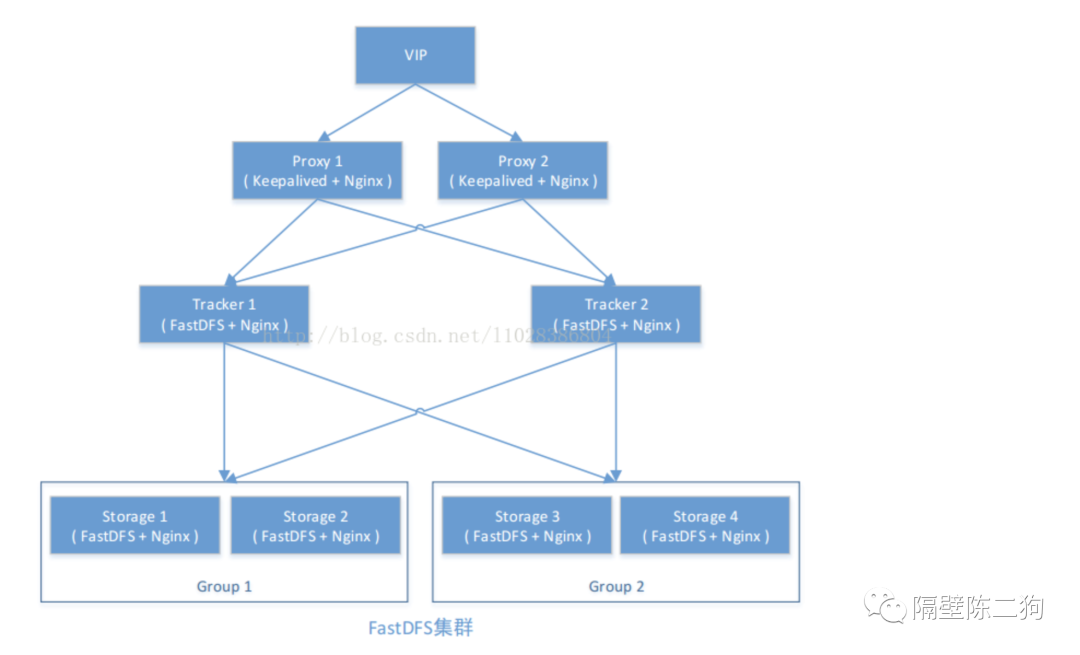集群架构图

先来简单说一下这个架构图,前段是两台nginx + keepalived的高可用负载均衡群集,对后面两个tracker服务器做负载均衡,然后最后端是由fastdfs组成的分布式存储池,通过tracker进行跟踪控制,文件调度等
环境介绍
前段 nginx + keepalived (两台机器,一主一备 192.168.3.21/22)
tracker服务器 nginx fastdfs tracker(两台机器,对等关系 192.168.3.19.20)
storage服务器 nginx fastdfs storage fastdfs相关模块 (两台机器,对等的两组 192.168.3.23/24)
keepalived结合nginx做高可用的负载均衡
由于前端只是用来做简单的负载均衡,不需要装载其他的模块,直接简单安装一下即可,如果是生产环境下,则最好统一安装编译,保持一致性
1)安装nginx
不再多说,自行Google
2)安装keepalived
cd /usr/local/src && wget http://www.keepalived.org/software/keepalived-1.2.18.tar.gz
tar zxf keepalived-1.2.18.tar.gz && cd keepalived-1.2.18
./configure —prefix=/usr/local/keepalived && make && make install
3)拷贝文件至默认的目录
mkdir /etc/keepalived
cp /usr/local/keepalived/etc/keepalived/keepalived.conf /etc/keepalived/
cp /usr/local/keepalived/etc/rc.d/init.d/keepalived /etc/init.d/
cp /usr/local/keepalived/etc/sysconfig/keepalived /etc/sysconfig/
ln -s /usr/local/sbin/keepalived /usr/sbin/
ln -s /usr/local/keepalived/sbin/keepalived /sbin/
4)添加至系统服务和开机启动
# cat /lib/systemd/system/keepalived.service
[Unit]
Description=Keepalived
After=syslog.target network.target remote-fs.target nss-lookup.target
[Service]
Type=forking
PIDFile=/var/run/keepalived.pid
ExecStart=/usr/local/keepalived/sbin/keepalived -D
ExecReload=/bin/kill -s HUP $MAINPID
ExecStop=/bin/kill -s QUIT $MAINPID
PrivateTmp=true
[Install]
WantedBy=multi-user.target
#systemctl daemon-reload
#systremctl enable keepalived
#systemctl start keepalived
注意:
至此,两台机器执行同样的操作,安装nginx和keepalived服务,然后添加系统服务等
5)修改主备的配置文件
# cat /etc/keepalived/keepalived.conf
! Configuration File for keepalived
global_defs {
router_id master
}
vrrp_script chk_nginx {
script "/etc/keepalived/nginx_check.sh"
interval 2
weight -20
}
vrrp_instance VI_1 {
state MASTER
interface enp0s3
virtual_router_id 33
mcast_src_ip 192.168.3.21
priority 100
nopreemt
advert_int 1
authentication {
auth_type PASS
auth_pass 1111
}
track_script {
chk_nginx
}
virtual_ipaddress {
192.168.3.100
}
}
[root@keepalived-nginx-backup /etc/keepalived]# cat /etc/keepalived/keepalived.conf
! Configuration File for keepalived
global_defs {
router_id backup
}
vrrp_script chk_nginx {
script "/etc/keepalived/nginx_check.sh"
interval 2
weight -20
}
vrrp_instance VI_1 {
state BACKUP
interface enp0s3
virtual_router_id 33
mcast_src_ip 192.168.3.22
priority 90
advert_int 1
authentication {
auth_type PASS
auth_pass 1111
}
track_script {
chk_nginx
}
virtual_ipaddress {
192.168.3.100
}
}
6)编写nginx状态监控脚本
# cat /etc/keepalived/nginx_check.sh
#!/bin/bash
A=`ps -C nginx –no-header |wc -l`
if [ $A -eq 0 ];then
/usr/local/nginx/sbin/nginx
sleep 2
if [ `ps -C nginx --no-header |wc -l` -eq 0 ];then
killall keepalived
fi
fi
注意:这个脚本存在一些问题,需要把 —no-header 去掉,否则nginx会报错,起不来,显示端口被占用

7)测试
大体的思路就是,两台机器在访问时做好区分,然后主上停掉keepalived和nginx,在浏览器上访问vip,看能否访问,切到备上,看下vip是否飘过来,再看下系统日志关于keepalived的VIP的状态信息等。
搭建fastdfs的tracker服务器
略
tracker机器上的nginx不用添加fastdfs-ngx-mod 模块
搭建fastdfs的storage服务器
略
修改配置文件
1)将storage和tracker服务器联系起来
在tracker服务器上做以下修改:
# egrep -v "^#|^$" tracker.conf
disabled=false
bind_addr=
port=22122
connect_timeout=30
network_timeout=60
base_path=/data/tracker
max_connections=256
accept_threads=1
work_threads=4
min_buff_size = 8KB
max_buff_size = 128KB
store_lookup=2
store_group=group2
store_server=0
store_path=0
download_server=0
reserved_storage_space = 10%
log_level=info
run_by_group=
run_by_user=
allow_hosts=*
sync_log_buff_interval = 10
check_active_interval = 120
thread_stack_size = 64KB
storage_ip_changed_auto_adjust = true
storage_sync_file_max_delay = 86400
storage_sync_file_max_time = 300
use_trunk_file = false
slot_min_size = 256
slot_max_size = 16MB
trunk_file_size = 64MB
trunk_create_file_advance = false
trunk_create_file_time_base = 02:00
trunk_create_file_interval = 86400
trunk_create_file_space_threshold = 20G
trunk_init_check_occupying = false
trunk_init_reload_from_binlog = false
trunk_compress_binlog_min_interval = 0
use_storage_id = false
storage_ids_filename = storage_ids.conf
id_type_in_filename = ip
store_slave_file_use_link = false
rotate_error_log = false
error_log_rotate_time=00:00
rotate_error_log_size = 0
log_file_keep_days = 0
use_connection_pool = false
connection_pool_max_idle_time = 3600
http.server_port=8000
http.check_alive_interval=30
http.check_alive_type=tcp
http.check_alive_uri=/status.html
# egrep -v "^#|^$" client.conf
connect_timeout=30
network_timeout=60
base_path=/data/tracker
tracker_server=192.168.3.20:22122
tracker_server=192.168.3.19:22122
log_level=info
use_connection_pool = false
connection_pool_max_idle_time = 3600
load_fdfs_parameters_from_tracker=false
use_storage_id = false
storage_ids_filename = storage_ids.conf
http.tracker_server_port=8000
修改nginx配置文件,使其反向代理后端storage服务器
# egrep -v "^#|^$" /usr/local/nginx/conf/nginx.conf
user root;
worker_processes 1;
events {
worker_connections 1024;
use epoll;
}
http {
include mime.types;
default_type application/octet-stream;
#log_format main '$remote_addr - $remote_user [$time_local] "$request" '
# '$status $body_bytes_sent "$http_referer" '
# '"$http_user_agent" "$http_x_forwarded_for"';
#access_log logs/access.log main;
sendfile on;
tcp_nopush on;
#keepalive_timeout 0;
keepalive_timeout 65;
#gzip on;
#设置缓存
server_names_hash_bucket_size 128;
client_header_buffer_size 32k;
large_client_header_buffers 4 32k;
client_max_body_size 300m;
proxy_redirect off;
proxy_set_header Host $http_host;
proxy_set_header X-Real-IP $remote_addr;
proxy_set_header X-Forwarded-For $proxy_add_x_forwarded_for;
proxy_connect_timeout 90;
proxy_send_timeout 90;
proxy_read_timeout 90;
proxy_buffer_size 16k;
proxy_buffers 4 64k;
proxy_busy_buffers_size 128k;
proxy_temp_file_write_size 128k;
#设置缓存存储路径、存储方式、分配内存大小、磁盘最大空间、缓存期限
proxy_cache_path /data/cache/nginx/proxy_cache levels=1:2
keys_zone=http-cache:200m max_size=1g inactive=30d;
proxy_temp_path /data/cache/nginx/proxy_cache/tmp;
#设置 group1 的服务器
upstream fdfs_group1 {
#server 10.0.3.89:8888 weight=1 max_fails=2 fail_timeout=30s;
server 192.168.3.23:8888 weight=1 max_fails=2 fail_timeout=30s;
}
#设置 group2 的服务器
upstream fdfs_group2 {
#server 10.0.3.88:8888 weight=1 max_fails=2 fail_timeout=30s;
server 192.168.3.24:8888 weight=1 max_fails=2 fail_timeout=30s;
}
server {
listen 8000;
server_name localhost;
#设置 group 的负载均衡参数
location /group1/M00 {
proxy_next_upstream http_502 http_504 error timeout invalid_header;
proxy_cache http-cache;
proxy_cache_valid 200 304 12h;
proxy_cache_key $uri$is_args$args;
proxy_pass http://fdfs_group1;
expires 30d;
}
location /group2/M00 {
proxy_next_upstream http_502 http_504 error timeout invalid_header;
proxy_cache http-cache;
proxy_cache_valid 200 304 12h;
proxy_cache_key $uri$is_args$args;
proxy_pass http://fdfs_group2;
expires 30d;
}
#error_page 404 /404.html;
# redirect server error pages to the static page /50x.html
#
error_page 500 502 503 504 /50x.html;
location = /50x.html {
root html;
}
}
}
两台tracker服务器相对应就可以啦
2)修改storage服务器
# egrep -v "^$|^#" storage.conf
disabled=false
group_name=group1
bind_addr=
client_bind=true
port=23000
connect_timeout=30
network_timeout=60
heart_beat_interval=30
stat_report_interval=60
base_path=/data/storage
max_connections=256
buff_size = 256KB
accept_threads=1
work_threads=4
disk_rw_separated = true
disk_reader_threads = 1
disk_writer_threads = 1
sync_wait_msec=50
sync_interval=0
sync_start_time=00:00
sync_end_time=23:59
write_mark_file_freq=500
store_path_count=1
store_path0=/data/storage
subdir_count_per_path=256
tracker_server=192.168.3.19:22122
tracker_server=192.168.3.20:22122
log_level=info
run_by_group=
run_by_user=
allow_hosts=*
file_distribute_path_mode=0
file_distribute_rotate_count=100
fsync_after_written_bytes=0
sync_log_buff_interval=10
sync_binlog_buff_interval=10
sync_stat_file_interval=300
thread_stack_size=512KB
upload_priority=10
if_alias_prefix=
check_file_duplicate=0
file_signature_method=hash
key_namespace=FastDFS
keep_alive=0
use_access_log = false
rotate_access_log = false
access_log_rotate_time=00:00
rotate_error_log = false
error_log_rotate_time=00:00
rotate_access_log_size = 0
rotate_error_log_size = 0
log_file_keep_days = 0
file_sync_skip_invalid_record=false
use_connection_pool = false
connection_pool_max_idle_time = 3600
http.domain_name=
http.server_port=8888
# egrep -v "^$|^#" mod_fastdfs.conf
connect_timeout=100
network_timeout=300
base_path=/tmp
load_fdfs_parameters_from_tracker=true
storage_sync_file_max_delay = 86400
use_storage_id = false
storage_ids_filename = storage_ids.conf
tracker_server=192.168.3.19:22122
tracker_server=192.168.3.20:22122
storage_server_port=23000
group_name=group1
url_have_group_name = true
store_path_count=1
store_path0=/data/storage
log_level=info
log_filename=
response_mode=proxy
if_alias_prefix=
flv_support = true
flv_extension = flv
group_count = 2
[group1]
group_name=group1
storage_server_port=23000
store_path_count=1
store_path0=/data/storage
[group2]
group_name=group2
storage_server_port=23000
store_path_count=1
store_path0=/data/storage
修改nginx的配置文件
# egrep -v "^$|^#" /usr/local/nginx/conf/conf.d/storage.conf
server {
listen 8888;
server_name localhost;
location ~/group([0-9])/M00 {
#alias /fastdfs/storage/data;
ngx_fastdfs_module;
}
error_page 500 502 503 504 /50x.html;
location = /50x.html {
root html;
}
}
两台storage服务器保持对应即可。
3)修改负载均衡器的配置文件
# egrep -v "^$|^#" nginx.conf
user root;
worker_processes 1;
events {
worker_connections 1024;
}
http {
include mime.types;
default_type application/octet-stream;
#log_format main '$remote_addr - $remote_user [$time_local] "$request" '
# '$status $body_bytes_sent "$http_referer" '
# '"$http_user_agent" "$http_x_forwarded_for"';
#access_log logs/access.log main;
sendfile on;
#tcp_nopush on;
#keepalive_timeout 0;
keepalive_timeout 65;
proxy_read_timeout 150;
#gzip on;
## FastDFS Tracker Proxy
upstream fastdfs_tracker {
#server 10.0.3.90:8000 weight=1 max_fails=2 fail_timeout=30s;
#server 10.0.3.90:8000 weight=1 max_fails=2 fail_timeout=30s;
server 192.168.3.19:8000 weight=1 max_fails=2 fail_timeout=30s;
server 192.168.3.20:8000 weight=1 max_fails=2 fail_timeout=30s;
}
server {
listen 80;
server_name localhost;
#charset koi8-r;
#access_log logs/host.access.log main;
location / {
root html;
index index.html index.htm;
}
#error_page 404 /404.html;
# redirect server error pages to the static page /50x.html
error_page 500 502 503 504 /50x.html;
location = /50x.html {
root html;
}
## FastDFS Proxy
location /dfs {
root html;
index index.html index.htm;
proxy_pass http://fastdfs_tracker/;
proxy_set_header Host $http_host;
proxy_set_header Cookie $http_cookie;
proxy_set_header X-Real-IP $remote_addr;
proxy_set_header X-Forwarded-For $proxy_add_x_forwarded_for;
proxy_set_header X-Forwarded-Proto $scheme;
client_max_body_size 300m;
}
}
}
剩下的就是测试了
1)先测试fastdfs
我们在tracker服务器上传一张图片,然后在storage服务器上访问
/usr/bin/fdfs_upload_file /etc/fdfs/client.conf image.jpg

然后我们在访问tracker服务器,看是否能反向代理到后端storage上

2)测试负载均衡器
我们访问负载均衡器的VIP,来看下是否能访问

至此,,一个简单的fastdfs高可用的负载均衡集群已经搭建完毕,后面我们再做一些优化。






